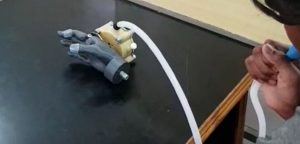
A new hand prosthesis powered and controlled by the user’s breathing has been developed by researchers at the University of Oxford. The lightweight device offers an alternative to cable-driven body-powered prosthetics, which can be challenging for people too young or anatomically unsuited to manage the device. Cable-driven body-powered systems can also be expensive to own and maintain in low-resource settings because of the costs associated with fitting and maintenance.
“Our breathing-powered device provides a novel prosthetic option that can be used without limiting any of the user’s body movements. It is one of the first truly new design approaches for power and control of a body-powered prosthetic since the emergence of the cable-driven system over two centuries ago,” said Jeroen Bergmann, PhD, a professor in the Department of Engineering Science at the university of Oxford, and senior author of a paper describing the device.
By regulating their breathing, users power a small purpose-built Tesla turbine that can accurately control the prosthetic finger movements. The volume of air needed to power the unit can be achieved by young children and the gearing in the unit determines the speed of the grasping action. Minimal maintenance and training are needed for ease of use in comparison to other prosthetic options, according to the study’s authors.
The researchers worked with the LimbBo Foundation, a UK-based charity for children with limb differences, to develop and refine the device.
“One of our aims at The LimbBo Foundation is to ensure that all our children have access to any devices which will aid their day-to-day lives. No two limb differences are the same, and what will help one child will not be suitable for another. Currently, there is some choice available regarding prosthetics, but there are still children who need a completely different approach. For many, their lack of an elbow joint severely limits their access to prosthetic devices…,” said Jane Hewitt, the organization’s trustee.
A spokesperson from Mobility India, a non-governmental organization based in Bengaluru, which worked with the researcher team on user testing, said: “The breathing-powered prosthetic, Airbender, has the potential to broaden prosthetic options for children and adolescents, especially in India and other developing countries that lack appropriate technology.”
Editor’s note: This story was adapted from materials provided by the University of Oxford.
The paper, “Reimagining prosthetic control: A novel body-powered prosthetic system for simultaneous control and actuation,” was published in the journal Prosthesis.




